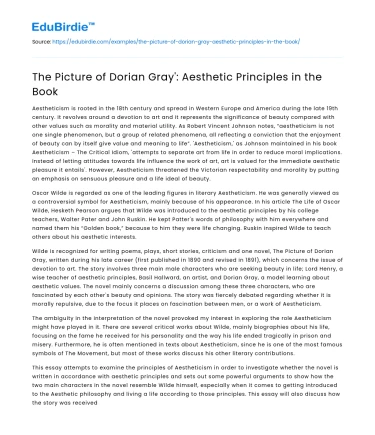Aestheticism is rooted in the 18th century and spread in Western Europe and America during the late 19th century. It revolves around a devotion to art and it represents the significance of beauty compared with other values such as morality and material utility. As Robert Vincent Johnson notes, “aestheticism is not one single phenomenon, but a group of related phenomena, all reflecting a conviction that the enjoyment of beauty can by itself give value and meaning to life”. 'Aestheticism,' as Johnson maintained in his book Aestheticism – The Critical Idiom, 'attempts to separate art from life in order to reduce moral implications. Instead of letting attitudes towards life influence the work of art, art is valued for the immediate aesthetic pleasure it entails'. However, Aestheticism threatened the Victorian respectability and morality by putting an emphasis on sensuous pleasure and a life ideal of beauty.
Oscar Wilde is regarded as one of the leading figures in literary Aestheticism. He was generally viewed as a controversial symbol for Aestheticism, mainly because of his appearance. In his article The Life of Oscar Wilde, Hesketh Pearson argues that Wilde was introduced to the aesthetic principles by his college teachers, Walter Pater and John Ruskin. He kept Patter's words of philosophy with him everywhere and named them his “Golden book,” because to him they were life changing. Ruskin inspired Wilde to teach others about his aesthetic interests.
Save your time!
We can take care of your essay
- Proper editing and formatting
- Free revision, title page, and bibliography
- Flexible prices and money-back guarantee
Wilde is recognized for writing poems, plays, short stories, criticism and one novel, The Picture of Dorian Gray, written during his late career (first published in 1890 and revised in 1891), which concerns the issue of devotion to art. The story involves three main male characters who are seeking beauty in life; Lord Henry, a wise teacher of aesthetic principles, Basil Hallward, an artist, and Dorian Gray, a model learning about aesthetic values. The novel mainly concerns a discussion among these three characters, who are fascinated by each other's beauty and opinions. The story was fiercely debated regarding whether it is morally repulsive, due to the focus it places on fascination between men, or a work of Aestheticism.
The ambiguity in the interpretation of the novel provoked my interest in exploring the role Aestheticism might have played in it. There are several critical works about Wilde, mainly biographies about his life, focusing on the fame he received for his personality and the way his life ended tragically in prison and misery. Furthermore, he is often mentioned in texts about Aestheticism, since he is one of the most famous symbols of The Movement, but most of these works discuss his other literary contributions.
This essay attempts to examine the principles of Aestheticism in order to investigate whether the novel is written in accordance with aesthetic principles and sets out some powerful arguments to show how the two main characters in the novel resemble Wilde himself, especially when it comes to getting introduced to the Aesthetic philosophy and living a life according to those principles. This essay will also discuss how the story was received by society, how Wilde changed the text, and why he refuted the mainstream ideology of the Victorian era. The writer holds the idea that Wilde uses The Picture of Dorian Gray to show his own interpretations of Aestheticism.
The theoretical approach that is used in this essay is based on the perspectives of New Historicism. 'In New Historicism it is important to research the author's life, the author's social surrounding and how people reasoned during the author's lifetime and relate that information to the literary work'.
This essay will start by tracing biographical elements in the novel; how two literary works influenced it and how the two main characters actually resemble Wilde himself. It will then pay attention to aesthetic objectives and the aesthetic style, Victorian influences on Aestheticism, as well as explore how the story was received and why Wilde revised the novel.






 Stuck on your essay?
Stuck on your essay?

